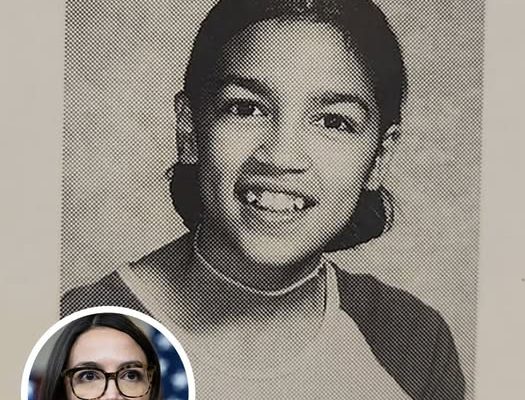Representative Alexandria Ocasio-Cortez, one of the most recognizable progressive voices in American politics, is once again under scrutiny—not for her policies or her sharp critiques of opponents, but for her personal story. For years, she has leaned heavily on her image as a tough “Bronx girl” who rose from modest beginnings to national prominence. Yet resurfacing details from her youth in the New York suburbs are reigniting debate about whether that narrative truly reflects her upbringing.
From “Sandy” to AOC
Long before she was known as the outspoken congresswoman representing New York’s 14th District, Ocasio-Cortez was known simply as “Sandy” among classmates at Yorktown High School in Westchester County, about 35 miles north of the Bronx. Her former teachers and peers recall her as a gifted student who excelled in academics, participated in the Intel International Science and Engineering Fair, and impressed adults with her ability to explain complex ideas in plain language.
“She was incredible,” said Michael Blueglass, one of her science teachers, in a 2018 interview. “She could take something difficult and make it understandable for everyone. She was one of the best I’ve ever seen.”
That bright teenager would eventually reinvent herself as Alexandria Ocasio-Cortez, the fiery progressive who toppled a longtime Democratic incumbent in 2018. But the contrast between her suburban upbringing and her carefully cultivated Bronx identity continues to generate controversy.
The Bronx Claim and the Suburban Reality
Born in the Bronx, Ocasio-Cortez moved with her family to Yorktown Heights when she was five years old. While she has acknowledged spending time in both places, her political brand has consistently emphasized her Bronx roots. On the campaign trail, in speeches, and on social media, she frequently references her identity as a Bronx native.
Most recently, she took a jab at former President Donald Trump, quipping that women from the Bronx could “eat Queens boys for breakfast.” It was one of many comments that highlighted her Bronx identity while downplaying the years she spent in relative comfort in Westchester.
Critics argue this is more than just political theater—it’s a deliberate attempt to rewrite history.
“She’s twisting herself in knots to dodge the fact that she was raised in the suburbs,” said New York State Assemblyman Matt Slater, a Republican from Yorktown. “We all remember her as Sandy Cortez from Westchester. Now she’s scrambling to rewrite the past.”
Yearbooks, Photos, and Pushback
Slater, who attended Yorktown High while Ocasio-Cortez was a freshman, recently posted her yearbook photo online. The picture quickly went viral, sparking debate across social media platforms. For her critics, it was proof that she had glossed over her suburban background. For her supporters, it was another attempt to undermine a woman of color who has shaken up Washington’s political establishment.
Ocasio-Cortez didn’t remain silent. Responding to the resurfaced images and the criticism, she defended her identity on X, writing: “I’m proud of my background. My mom worked as a house cleaner, and I helped her out. We even bartered housework for SAT tutoring.”
She insisted that her upbringing gave her a unique perspective: “Growing up between two vastly different communities—Yorktown and the Bronx—showed me inequality firsthand. That perspective is why I fight so hard for change today.”
Identity Politics Meets Political Branding
This isn’t the first time Ocasio-Cortez’s biography has come under attack. Since her shocking victory in 2018, opponents have tried to undermine her credibility by focusing on her past rather than her policies. The argument usually follows the same line: if she grew up in a relatively affluent suburb, how authentic is her claim to working-class roots?
But defenders say this criticism misses the point. Her family’s move to Westchester was not an escape into wealth but a bid to secure better schools for their children. Her father worked as an architect, her mother as a cleaner, and the family still struggled financially after his death in 2008. Ocasio-Cortez worked side jobs to help her mother keep their home.
Her supporters argue that this is precisely what makes her story resonate—navigating between two worlds, never fully belonging to either.
The Political Stakes
Still, the resurfacing of her past carries political weight. Ocasio-Cortez has become a symbol for progressive politics, and symbols are judged as much by image as by ideology. Critics see her Bronx identity as part of that carefully built brand. By painting herself as a product of the Bronx, she ties her story to the borough’s history of resilience, poverty, and cultural pride.
If that narrative appears exaggerated or disingenuous, it risks undercutting her authenticity—an asset that has defined her political career.
A Story That Won’t Go Away
Whether she is remembered as “Sandy from Westchester” or “the Bronx firebrand,” the debate over Ocasio-Cortez’s past shows no signs of fading. For some, it is evidence of political opportunism. For others, it reflects the reality of American life: families move, identities shift, and people grow into multiple communities at once.
What is clear is that the congresswoman isn’t backing down. “Experiencing both privilege and struggle shaped my worldview,” she wrote in defense of her story. “That duality is why I fight for justice—for the kids growing up in both the Bronx and the suburbs.”
For now, her critics will continue to post yearbook photos and childhood anecdotes, while her supporters insist those details only reinforce the complexity of her journey. Either way, Alexandria Ocasio-Cortez remains at the center of a cultural and political tug-of-war over identity, authenticity, and what it means to claim a place as your own.



